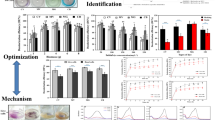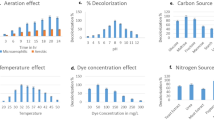Abstract
Polyporus sp. S133 decolorized the Amaranth in 72 h (30 mg L−1) under static and shaking conditions. Liquid medium containing glucose has shown the highest decolorization of Amaranth by Polyporus sp. S133. When the effect of increasing inoculum concentration on decolorization of Amaranth was studied, maximum decolorization was observed with 15 % inoculum concentration. Significant increase in the enzyme production of laccase (102.2 U L−1) was observed over the period of Amaranth decolorization compared to lignin peroxidase and manganese peroxidase. Germination rate of Sorghum vulgare and Triticum aestivum was less with Amaranth treatment as compared to metabolites obtained after its decolorization. Based on the metabolites detected by GC–MS, it was proposed that Amaranth was bio-transformed into two intermediates, 1-hydroxy-2-naphthoic acid and 1,4-naphthaquinone. Overall findings suggested the ability of Polyporus sp. S133 for the decolorization of azo dye and ensured the ecofriendly degradation of Amaranth.







Similar content being viewed by others
References
Raffi F, Hall JD, Cerniglia CE (1997) Mutagenicity of azo dyes used in foods, drugs and cosmetics before and after reduction by Clostridium species from the human intestinal tract. Food Chem Toxicol 35:897–901
Van der Zee FP, Villaverde S (2005) Combined anaerobic–aerobic treatment of azo dyes—a short review of bioreactor studies. Water Res 39:1425–1440
Maguire RJ (1992) Occurrence and persistence of dyes in a Canadian river. Water Sci Technol 25:265–270
Selvam K, Swaminathan K, Keo-Sang C (2003) Microbial decolorization of azo dyes and dye industry effluent by Fomes lividus. World J Microbiol Biotechnol 19:591–593
Barragan BE, Costa C, Marquez MC (2004) Biodegradation of azo dyes by bacteria inoculated on solid media. Dyes Pigm 75:73–81
Venugopal R, Tollefson L, Hyman FN, Timbo B, Joyce RE, Klontz KC (1996) Recalls of foods and cosmetics by the US Food and Drug Administration. J Food Prot 59:876–880
Ali H, Ahmad W, Haq T (2009) Decolorization and degradation of Malachite Green by Aspergillus flavus and Alternaria solani. Afr J Biotechnol 8:1574–1576
Chen CY, Kuo JT, Cheng CY, Huang YT, Ho IH, Chung YC (2009) Biological decolorization of dye solution containing Malachite Green by Pandoraea pulmonicola YC32 using a batch and continuous system. J Hazard Mater 172:1439–1445
Wu J, Jung BG, Kim KS, Lee YC, Sung NC (2009) Isolation and characterization of Pseudomonas otitidis WL-13 and its capacity to decolorize triphenylmethane dyes. J Environ Sci 21:960–964
Du LN, Wang S, Li G, Wang B, Jia XM, Zhao YH, Chen YL (2011) Biodegradation of Malachite Green by Pseudomonas sp. Strain DY1 under aerobic condition: characteristics, degradation products, enzyme analysis and phytotoxicity. Ecotoxicology 20:438–446
Ayed L, Chaieb K, Cheref A, Bakhrouf A (2009) Biodegradation of phenylmethane dye Malachite Green by Sphingomonas paucimobilis. World J Microbiol Biotechnol 25:705–711
Chen KC, Wu JY, Liou DJ, Hwang SCJ (2003) Decolorization of the textile dyes by newly isolated bacterial strains. J Biotechnol 101:57–68
Pandey A, Singh P, Iyengar L (2007) Bacterial decolorization and degradation of azo dyes. Int Biodet Biodegr 59:73–84
Knapp JS, Newby PS, Reece LP (1995) Decolorization of dyes by wood-rotting basidiomycete fungi. Enzyme Microbial Technol 171:664–668
Fu Y, Viraraghavan T (2002) Dye biosorption sites in Aspergillus niger. Bioresour Technol 82:139–145
Hadibarata T, Yusoff ARM, Aris A, Salmiati, Hidayat T, Kristanti RA (2012) Decolorization of azo, triphenylmethane and anthraquinone dyes by laccase of a newly isolated Armillaria sp. F022. Water Air Soil Pollut 223:1045–1054
Shedbalkar UU, Dhanve RS, Jadhav JP (2008) Biodegradation of triphenylmethane dye cotton blue by Penicillium ochrochloron MTCC 517. J Hazard Mater 157:472–479
Jadhav JP, Parshetti GK, Kalme SD, Govindwar SP (2007) Decolourization of azo dye methyl red by Saccharomyces cerevisiae MTCC 463. Chemosphere 68:394–400
Hadibarata T, Kristanti RA (2012) Effect of environmental factors in the decolorization of Remazol brilliant blue R by Polyporus sp. S133. J Chil Chem Soc 57:1095–1098
Kuwabara M, Glen JK, Morgan MA, Gold MH (1984) Separation and characterization of two extracellular H2O2-dependent oxidases from ligninolytic cultures of Phanaerochete chrysosporium. FEBS Lett 169:247–250
Hatvani N, Mecs I (2001) Production of laccase and manganese peroxidase by Lentinus edodes on malt containing by product of the brewing process. Process Biochem 37:491–496
Lucas M, Peres JA (2007) Degradation of Reactive Black 5 by fenton/UV-C and ferroxiate/H2O2/solar light processes. Dyes Pigm 74:622–629
Kalme SD, Parshetti GK, Jadhav SU, Govindwar SP (2006) Biodegradation of benzidine based dye direct blue-6 by Pseudomonas desmolyticum NCIM 2112. Bioresour Technol 98:1405–1410
Ali H (2010) Biodegradation of synthetic dyes—a review. Water Air Soil Poll 213:251–273
Hadibarata T, Kristanti RA (2012) Identification of metabolites from benzo[a]pyrene oxidation by ligninolytic enzymes of Polyporus sp. S133. J Environ Manag 111:115–119
Kaushik P, Malik A (2009) Fungal dye decolourization: recent advances and future potential. Environ Intern 35:127–141
Hadibarata T, Khudhair AB, Salim MR (2012) Breakdown products in the metabolic pathway of anthracene degradation by a ligninolytic fungus Polyporus sp. S133. Water Air Soil Pollut 223:2201–2208
Parshetti GK, Telke AA, Kalyani DC, Govindwar SP (2010) Decolorization and detoxification of sulfonated azo dye methyl orange by Kocuria rosea MTCC 1532. J Hazard Mater 176:503–509
Hadibarata T, Tachibana S, Askari M (2011) Identification of metabolites from phenanthrene oxidation by phenoloxidases and dioxygenases of Polyporus sp. S133. J Microbiol Biotechnol 21:299–304
Ghodake G, Jadhav U, Tamboli D, Kagalkar A, Govindwar S (2011) Decolorization of textile dyes and degradation of mono-azo dye amaranth by Acinetobacter calcoaceticus NCIM 2890. Indian J Microbiol 51:501–508
Hadibarata T, Yusoff ARM, Kristanti RA (2012) Decolorization and metabolism of anthraquinone type by laccase of white-rot fungi Polyporus sp. S133. Water Air Soil Pollut 223:933–941
Cha CJ, Doerge DR, Cerniglia CE (2001) Biotransformation of Malachite Green by the fungus Cunninghamella elegans. Appl Environ Microbiol 67:4358–4360
Parshetti GK, Kalme SD, Gomare SS, Govindwar SP (2007) Biodegradation of reactive blue 25 by Aspergillus ochraceus NCIM 1146. Biores Technol 98:3638–3642
Yan K, Wang H, Zhang X (2009) Biodegradation of crystal violet by low molecular mass fraction secreted by fungus. J Biosci Bioeng 108:421–424
Kalyani DC, Patil PS, Jadhav JP, Govindwar SP (2008) Biodegradation of reactive textile dye Red BLI by an isolated bacterium Pseudomonas sp. SUK1. Biores Technol 99:4635–4641
Muralikrishna C, Renganathan V (1993) Peroxidase-catalyzed desulfonation of 3,5-dimethyl-4-hydroxy and 3,5-dimethyl-4-aminobenzenesulfonic acids. Biochem Biophys Res Com 197:798–804
Liu X, Zhang J, Jiang J, Li R, Xie Z, Li S (2011) Biochemical degradation pathway of reactive blue 13 by Candida rugopelliculosa HXL-2. Int Biodeter Biodegr 65:135–141
Acknowledgments
A part of this research was financially supported by a University Research Grant of Universiti Teknologi Malaysia (Vote QJ1.3000.2522.02H65), which is gratefully acknowledged.
Author information
Authors and Affiliations
Corresponding author
Rights and permissions
About this article
Cite this article
Hadibarata, T., Nor, N.M. Decolorization and degradation mechanism of Amaranth by Polyporus sp. S133. Bioprocess Biosyst Eng 37, 1879–1885 (2014). https://doi.org/10.1007/s00449-014-1162-0
Received:
Accepted:
Published:
Issue Date:
DOI: https://doi.org/10.1007/s00449-014-1162-0




